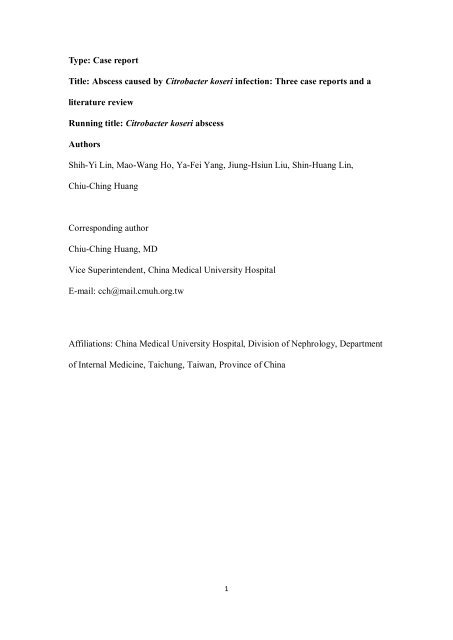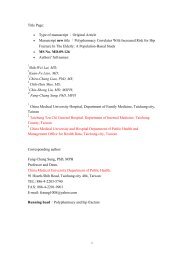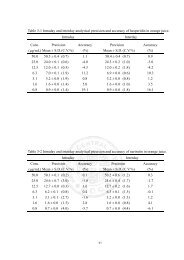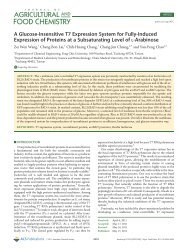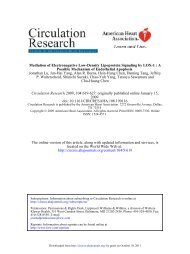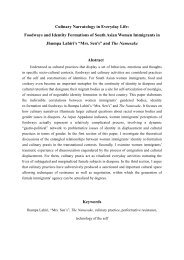Type: Case report Title: Abscess caused by Citrobacter koseri ...
Type: Case report Title: Abscess caused by Citrobacter koseri ...
Type: Case report Title: Abscess caused by Citrobacter koseri ...
Create successful ePaper yourself
Turn your PDF publications into a flip-book with our unique Google optimized e-Paper software.
<strong>Type</strong>: <strong>Case</strong> <strong>report</strong><br />
<strong>Title</strong>: <strong>Abscess</strong> <strong>caused</strong> <strong>by</strong> <strong>Citrobacter</strong> <strong>koseri</strong> infection: Three case <strong>report</strong>s and a<br />
literature review<br />
Running title: <strong>Citrobacter</strong> <strong>koseri</strong> abscess<br />
Authors<br />
Shih-Yi Lin, Mao-Wang Ho, Ya-Fei Yang, Jiung-Hsiun Liu, Shin-Huang Lin,<br />
Chiu-Ching Huang<br />
Corresponding author<br />
Chiu-Ching Huang, MD<br />
Vice Superintendent, China Medical University Hospital<br />
E-mail: cch@mail.cmuh.org.tw<br />
Affiliations: China Medical University Hospital, Division of Nephrology, Department<br />
of Internal Medicine, Taichung, Taiwan, Province of China<br />
1
Abstract<br />
In this <strong>report</strong>, we present 3 cases of abscess <strong>caused</strong> <strong>by</strong> <strong>Citrobacter</strong> <strong>koseri</strong>. All infected<br />
patients recovered after initial empirical antibiotic treatment and percutaneous<br />
drainage of the abscess. We reviewed the literature and found 9 adult cases of C.<br />
<strong>koseri</strong> abscess. In most of these cases, patients recovered after timely antibiotic<br />
treatment and drainage.<br />
Keywords: <strong>Citrobacter</strong> <strong>koseri</strong>, sepsis, renal abscess, iliopsoas abscess<br />
2
Introduction<br />
<strong>Citrobacter</strong> species, belonging to the family Enterobacteriaceae, are environmental<br />
organisms commonly found in soil, water, and the intestinal tracts of animals and<br />
humans. <strong>Citrobacter</strong> infections usually occur in hospital settings in patients with<br />
multiple co-morbidities and seldom cause disease in the general population (1).<br />
Neonates and immunocompromised hosts are highly susceptible to <strong>Citrobacter</strong><br />
infections, which are mainly <strong>caused</strong> <strong>by</strong> <strong>Citrobacter</strong> freundii and <strong>Citrobacter</strong> <strong>koseri</strong>. C.<br />
freundii is usually associated with hepatobiliary tract infections, while C. <strong>koseri</strong><br />
causes neonatal meningitis and brain abscess with high mortality rates (2). Few cases<br />
of C. <strong>koseri</strong> causing severe infections or abscess in adults have been <strong>report</strong>ed. In this<br />
<strong>report</strong>, we present 3 cases of <strong>Citrobacter</strong> abscess at different sites in adults.<br />
Unsatisfactory outcomes were obtained with initial conservative treatment, but<br />
complete recovery was achieved after invasive intervention combined with<br />
medication.<br />
<strong>Case</strong> 1<br />
A 72-year-old man with hepatitis B virus-related cirrhosis presented with fever and<br />
right thigh swelling for 5 days. On arrival, his body temperature was 37°C, blood<br />
pressure was 111/68 mm Hg, pulse was 108 beats per minute, and respiration rate was<br />
20 breaths per minute. Physical examination revealed local heat and tenderness over<br />
the right thigh area. Laboratory studies showed C-reactive protein concentration of<br />
15.6 mg/dL (normal level,
colonies on sheep blood agar after 24 h of incubation in 5% CO2 at 35°C. The<br />
biochemical profile identified the organism as C. <strong>koseri</strong>. The minimal inhibitory<br />
concentrations determined <strong>by</strong> antibiotic susceptibility tests were as follows:<br />
gentamicin,
Culture of the aspirated pus revealed C. <strong>koseri</strong>. The susceptibility test results were the<br />
same as <strong>report</strong>ed in case 1. Additionally, C. <strong>koseri</strong> displayed resistance to ampicillin<br />
but sensitivity to amoxicillin/clavulanic acid. No abnormal lesion was noted on<br />
colonoscopy. After completing a 14-day course of i.v. cefmetazole (1 g every 6 h) and<br />
drain removal, the patient was discharged with oral ceftibuten (200 mg twice daily for<br />
14 days). She had no more fever or abdominal pain, and the ESR decreased gradually<br />
from 85 to 27 mm/h.<br />
<strong>Case</strong> 3<br />
A 51-year-old diabetic woman presented with a 1-day complaint of fever and right<br />
flank pain. Her medical history included right nephrolithiasis and 3-vessel coronary<br />
artery disease. Her body temperature was 38.6°C, blood pressure was 96/61 mm Hg,<br />
pulse rate was 106 beats per minute, and respiration rate was 26 breaths per minute<br />
with a deep pattern. Laboratory studies showed a leukocyte count of 2.6 × 10 4 /μL<br />
(normal range, 3 to 9 × 10 3 /μL), C-reactive protein level of 20.7 mg/dL (normal level,<br />
empirically. The blood culture yielded C. <strong>koseri</strong>, and the sensitivity test results were<br />
the same as those in case 1. Based on the test results, we changed the antibiotic to i.v.<br />
cefazolin (500 mg every 12 h for 14 days). The patient was discharged thereafter, with<br />
oral cefradine (500 mg twice daily). However, she discontinued the use of oral<br />
cefradine and refused further outpatient follow-up. Septic shock developed weeks<br />
later. Non-enhanced CT showed a gas-forming abscess in segment 5–6 of the liver<br />
and a right renal abscess of 4.7 × 7.3 cm (Fig. 3A and 3B). CT-guided percutaneous<br />
drainage was performed for the abscesses of the kidney and liver. Cultures of urine,<br />
blood, and the aspirated pus showed C. <strong>koseri</strong> growth, and antimicrobial susceptibility<br />
test results matched those from the patient’s previous admission. Anaerobic culture of<br />
the pus revealed no growth. She was treated with i.v. ciprofloxacin (400 mg once<br />
daily for 4 weeks), and the drainage tube was removed after complete resolution. Oral<br />
ciprofloxacin (500 mg every 12 h) was prescribed for another month until the ESR<br />
decreased from >140 mm/h to a steady state of 60 mm/h. After 4 months of follow-up,<br />
the patient was asymptomatic and without detectable abscesses.<br />
Discussion<br />
C. <strong>koseri</strong> (previously classified as <strong>Citrobacter</strong> diversus) has long been recognized<br />
to be a cause of abscess in neonates. The literature about <strong>Citrobacter</strong> abscess in adults,<br />
however, is scanty (3). We performed a PubMed search with the terms “<strong>Citrobacter</strong><br />
<strong>koseri</strong>,” “<strong>Citrobacter</strong> diversus,” and “abscess.” Nine cases of abscess secondary to C.<br />
<strong>koseri</strong> infection in adults were found in this search (Table 1) (4-12).<br />
<strong>Case</strong>s 1 and 2 are the first <strong>report</strong>s describing favorable therapeutic outcomes for<br />
iliopsoas abscess <strong>caused</strong> <strong>by</strong> C. <strong>koseri</strong>. Iliopsoas abscess commonly occurs because of<br />
hematogenous spread from an occult source. Staphylococcus aureus is the leading<br />
6
causative organism. Iliopsoas abscess can also result from diseases of the<br />
genitourinary, gastrointestinal, or musculoskeletal systems, of which Streptococcus<br />
species and Escherichia coli are the 2 main causative pathogens (13). Iliopsoas<br />
abscess <strong>caused</strong> <strong>by</strong> C. <strong>koseri</strong> is, however, unusual. Vichib et al. described a<br />
retroperitoneal abscess <strong>caused</strong> <strong>by</strong> C. <strong>koseri</strong> that was lethal despite surgical drainage.<br />
Mortality in that case was attributed to an acute pulmonary event during sepsis (5). In<br />
treating iliopsoas abscesses less than 3 cm in diameter in immunocompetent patients,<br />
prolonged treatment (for weeks) with antibiotic alone can offer successful recovery<br />
(14). According to Witzigmann et al., Bufalari et al., and McClean et al., patients with<br />
iliopsoas abscess might benefit from directed drainage (15-17). Among our cases,<br />
both patients with iliopsoas abscess showed remarkable recovery after percutaneous<br />
drainage and prompt antibiotic treatment.<br />
With regard to case 3, urolithiasis and diabetes mellitus are 2 predisposing factors<br />
of renal abscess (18). A renal abscess usually results from an ascending infection.<br />
Renal abscess due to <strong>Citrobacter</strong> species is rare. Williams and Simmons described a<br />
case of <strong>Citrobacter</strong> perinephric abscess in a transplant recipient in 1974 (4). Our case<br />
is the first <strong>report</strong> of concurrent renal and liver abscesses <strong>caused</strong> <strong>by</strong><br />
community-acquired C. <strong>koseri</strong> in a diabetic patient. Although initially the renal<br />
abscess was small (less than 2 cm in diameter) and responded well to i.v. antibiotics<br />
during the first admission, the patient subsequently developed overwhelming<br />
septicemia, a liver abscess, and an enlarged renal abscess. The tendency of C. <strong>koseri</strong><br />
to form brain abscesses in neonates is recognized and is attributed to a specific 32-kD<br />
outer membrane protein of C. <strong>koseri</strong> and the immature neonatal brain blood barrier (3).<br />
Until now, though, there has been no known predisposition of C. <strong>koseri</strong> to form<br />
abscesses in adults. Thus, we suspect that the deteriorating infection in case 3 is<br />
7
elated to the discontinuation of antibiotics and, most importantly, the lack of drainage<br />
during the first admission.<br />
Instillation of antibiotic into abscesses does not improve the outcome in cases of<br />
<strong>Citrobacter</strong> infections. Different species of <strong>Citrobacter</strong> show different antimicrobial<br />
susceptibility profiles. These profiles should be referenced when choosing antibiotics<br />
to treat serious diseases. C. <strong>koseri</strong> is typically resistant to ampicillin but susceptible to<br />
aminoglycosides. In case 2, the initial undulating fever might have been due to a lack<br />
of direct drainage rather than β-lactam resistance. In C. <strong>koseri</strong> infection,<br />
aminoglycosides, carbapenems, fluoroquinolones, and third- or fourth-generation<br />
cephalosporins are considered effective, but some C. <strong>koseri</strong> strains may develop<br />
isolated resistance to β-lactams, aminoglycosides, and aztreonam (19). Thus, Shih et<br />
al. have proposed that a combination of β-lactams and aminoglycosides would be<br />
better at treating <strong>Citrobacter</strong> bacteremia than would a single agent (20). Until now,<br />
there has been no agreement on the use of monotherapy or combinations of antibiotics<br />
in treating <strong>Citrobacter</strong> abscesses. Empirical combination therapy would be<br />
appropriate in cases of shock, neutropenia, or nosocomial <strong>Citrobacter</strong> infections (21,<br />
22).<br />
Doran stated that it would be proper to initiate treatment of neonatal brain abscess<br />
with direct aspiration or drainage followed <strong>by</strong> antibiotics for 4 to 6 weeks (23).<br />
Among the 12 patients listed in Table 1, all 10 cases of contracted<br />
community-acquired <strong>Citrobacter</strong> infections received direct drainage or surgical<br />
intervention and cephalosporins, aminoglycosides, fluoroquinolones, or β-lactams,<br />
alone or in combination. At the end of therapy, 11 cases resolved completely, and 1<br />
resulted in death.<br />
<strong>Citrobacter</strong> species is not only a nosocomial pathogen but also a causative agent<br />
8
of community-acquired infection. We have presented 3 cases to prompt a clinical alert<br />
to the possibility of C. <strong>koseri</strong> abscess, even in immunocompetent people.<br />
9
References<br />
1. Schwartz D. <strong>Citrobacter</strong> infections. in: Pathology of Infectious Diseases. 1 st ed.<br />
Conn DH and Schwartz DA Eds. McGraw-Hill, New York, 1997:513-516.<br />
2. Holmes B, Aucken H. <strong>Citrobacter</strong>, Enterobacter, Klebsiella, Serratia and other<br />
members of the Enterobacteriaceae. in: Topley and Wilson's Microbiology and<br />
Microbial Infections. 9 th ed. Balows A and Duerden BI Eds. Arnolds, London,<br />
1998: Vol 2:999-1033.<br />
3. Kariholu U, Rawal J, Namnyak S. Neonatal <strong>Citrobacter</strong> <strong>koseri</strong> meningitis and<br />
brain abscess. Internet J Pediatr Neonatol 10: , 2009.<br />
4. Williams R, Simmons R. <strong>Citrobacter</strong> perinephric abscess presenting as<br />
pneumoscrotum in transplant recipient. Urology 3:478-480, 1974.<br />
5. Vichib T, Farinaa U, Bartolettia A. A rare case of lethal retroperitoneal abscess<br />
<strong>caused</strong> <strong>by</strong> <strong>Citrobacter</strong> <strong>koseri</strong>. Urol Int 79:364-366, 2007.<br />
6. Cho K, Maklad N, Curran J, Ting Y. Angiographic and ultrasonic findings in<br />
infected simple cysts of the kidney. AJR 127:1015-1019, 1976.<br />
7. Lee Jr F, Lee F, Solomon M, Straub W, McLeary R. Sonographic<br />
demonstration of prostatic abscess. J Ultrasound Med 5:101-102, 1986.<br />
8. Booth L, Palmer J, Pateman J, Tuck A. <strong>Citrobacter</strong> diversus ventriculitis and<br />
brain abscesses in an adult. J Infect 26:207-209, 1993.<br />
9. Civen R, Vaeisaenen M, Finegold S. Peritonsillar abscess, retropharyngeal<br />
abscess, mediastinitis, and nonclostridial anaerobic myonecrosis: a case <strong>report</strong>.<br />
Clin Infect Dis 16:299-303, 1993.<br />
10. Farr R, Khakoo R, Maxwell L, Hill R. <strong>Citrobacter</strong> pericarditis secondary to a<br />
subphrenic abscess. Clin Infect Dis 18:838-839, 1994.<br />
10
11. Canario D, Reme P, Cunha B. <strong>Citrobacter</strong> <strong>koseri</strong> infection and abscess<br />
associated with Harrington rods. Am J Infect Control 32:372, 2004.<br />
12. Lind C, Muthiah K, Bok A. Peritumoral <strong>Citrobacter</strong> <strong>koseri</strong> abscess associated<br />
with parasagittal meningioma. Neurosurgery 57:E814, 2005.<br />
13. Mallick I, Thoufeeq M, Rajendran T. Iliopsoas abscesses. Postgrad Med J<br />
80:459-462, 2004.<br />
14. Yacoub WN, Sohn HJ, Chan S, et al. Psaos abscess rarely requires surgical<br />
intervention. Am J Surg 196:223-227, 2008.<br />
15. Witzigmann H, Geissler F, Uhlmann D, Hauss J. Intra-abdominal abscess.<br />
Chirurg 69:813-820, 1998.<br />
16. Bufalari A, Giustozzi G, Moggi L. Postoperative intraabdominal abscesses:<br />
percutaneous versus surgical treatment. Acta Chir Belg 5:197-200, 1996.<br />
17. McClean K, Sheehan G, Harding G. Intraabdominal infection: a review. Clin<br />
Infect Dis 19:100-116, 1994.<br />
18. Coelho R, Schneider-Monteiro E, Mesquita J, Mazzucchi E, Marmo Lucon A,<br />
Srougi M. Renal and perinephric abscesses: analysis of 65 consecutive cases.<br />
World J Surg 31:431-436, 2007.<br />
19. El Harrif-Heraud Z, Arpin C, Benliman S, Quentin C. Molecular epidemiology<br />
of a nosocomial outbreak due to SHV-4-producing strains of <strong>Citrobacter</strong><br />
diversus. J Clin Microbiol 35:2561-2567, 1997.<br />
20. Shih C, Chen Y, Chang S, Luh K, Hsieh W. Bacteremia due to <strong>Citrobacter</strong><br />
species: significance of primary intraabdominal infection. Clin Infect Dis<br />
23:543-549, 1996.<br />
21. Mohanty S, Singhal R, Sood S, Dhawn B, Kapil A, Das BK. <strong>Citrobacter</strong><br />
infections in a tertiary care hospital in Northern India. J Infect 54:58-64, 2007.<br />
11
22. Martinez JA, Cobos-Trigueros N, Soriano A, et al. Influence of empirical<br />
therapy with a β-lactam alone or combined with an aminoglycoside on<br />
prognosis of bacteremia due to gram-negative microorganisms. Antimicrob<br />
Agents Chemother Epub: 2010 June 28.<br />
23. Doran T. The role of <strong>Citrobacter</strong> in clinical disease of children: review. Clin<br />
Infect Dis 28:384-394, 1999.<br />
12


